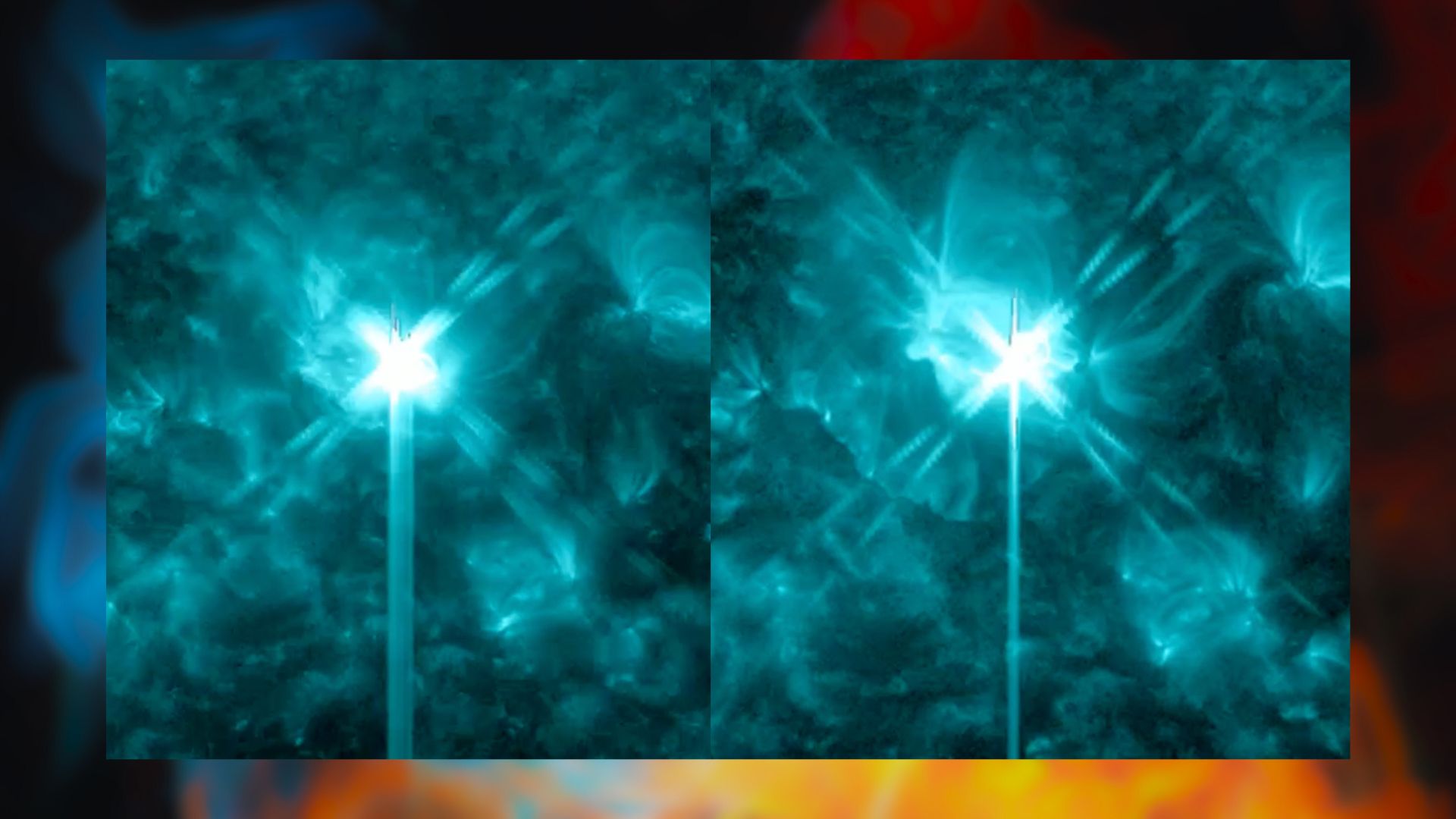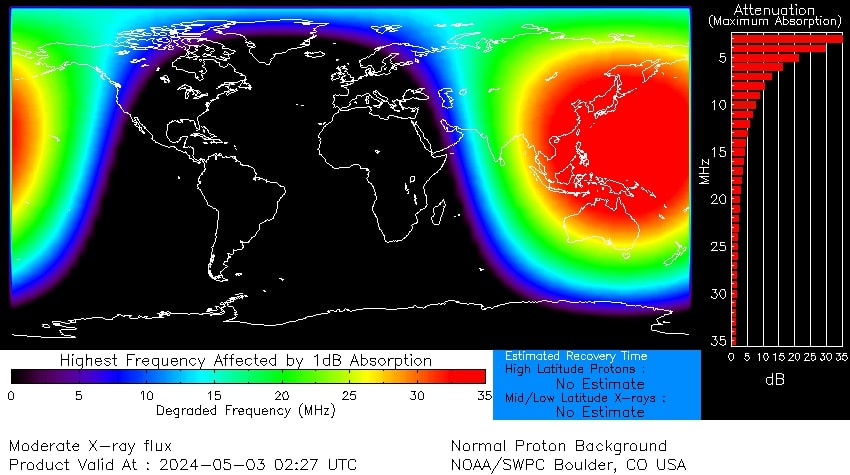2 colossal solar flares explode from the sun and Earth is in the firing line (video)
The dual-flare spectacle came from sunspot region AR3663.
Newly emerged sunspot region AR3663 is already making a name for itself, firing off not one but two powerful solar flares within just six hours of each other.
The first eruption occurred last night (May 2) when the sun released the most powerful category flare, an X-class solar flare, causing shortwave radio blackouts across Australia, Japan and much of China. The flare peaked at 10:22 p.m. EDT (0222 GMT) and ended shortly after at 10:27 p.m. EDT (0227 GMT). The next eruption came this morning (May 3) when the second most powerful category flare, an M-class solar flare, peaked around 4:00 a.m. EDT (0800 GMT).
The explosive sunspot was facing Earth at the time of both eruptions and it is possible that a coronal mass ejection (CME), a large expulsion of plasma and magnetic field, accompanied at least one of these solar flares. Shortly after the X-flare, the U.S. Air Force reported a Type II solar radio burst "a type of natural radio signal emitted by shocked gas at the leading edge of a CME," Spaceweather.com reported.
Related: NASA prepares for intense sun storms on Mars during solar maximum

If a CME is Earth-directed it can wreak havoc with power grids, telecommunication networks and orbiting satellites, as well as expose astronauts to dangerous doses of radiation. But they are a welcomed visitor for skywatchers as they can trigger geomagnetic storms which in turn spark dynamic aurora displays visible at latitudes beyond their 'normal' polar range.
You can stay tuned with the latest details concerning any Earth-directed components of the recent eruptions on the National Oceanic and Atmospheric Administration (NOAA) Space Weather Prediction Center's forecast discussion.
According to solar physicist Keith Strong, last night's X-flare was the 11th largest flare so far this cycle.
Get the Space.com Newsletter
Breaking space news, the latest updates on rocket launches, skywatching events and more!
"X FLARE! Sunspot region AR3663 just produced an X1.7 flare, the 11th largest flare so far this cycle. It was an impulsive flare lasting a total of about 25 minutes and peaking at 02:22 U.T," Strong posted on X.
X FLARE! Sunspot region AR3663 just produced an X1.7 flare, the 11th largest flare so far this cycle. It was an impulsive flare lasting a total of about 25 minutes and peaking at 02:22 U.T. This is the 30th X flare so far during SC25, compared to just 19 at the same stage in SC24 pic.twitter.com/zYgvqjm0AfMay 3, 2024
Solar flares, eruptions from the sun's surface, emit intense bursts of electromagnetic radiation. They occur when magnetic energy accumulating in the solar atmosphere is subsequently released. Solar flares are categorized by size into lettered groups, with X-class being the most powerful. Then there are M-class flares that are 10 times less powerful than X-class flares, followed by C-class flares which are 10 times weaker than M-class flares, B-class are 10 times weaker than C-class flares and finally, A-class flares which are 10 times weaker than B-class flares and have no noticeable consequences on Earth.
Within each class, numbers from 1-10 (and beyond for X-class flares) describe a flare's relative strength. Last night's flare clocked in at X1.69, according to Spaceweatherlive.com, measured by NASA's GOES-16 satellite, and this morning's flare peaked at M4.5.
Shortwave radio blackouts like the one witnessed over Australia, Japan and much of China last night are common shortly after powerful solar flare eruptions due to the strong pulse of X-rays and extreme ultraviolet radiation emitted during these events. The radiation travels toward Earth at the speed of light and ionizes (gives an electrical charge to) the top of Earth's atmosphere when it reaches us.
Related: Watch 4 solar flares erupt from the sun at nearly the same time in extremely rare event (video)

This ionization causes a higher-density environment for the high-frequency shortwave radio signals to navigate through in order to support communication over long distances. The radio waves that interact with electrons in the ionized layers lose energy due to more frequent collisions, and this can lead to radio signals becoming degraded or completely absorbed according to NOAA's Space Weather Prediction Center.
Solar activity is ramping up as we approach solar maximum, the peak of solar activity during the sun's approximately 11-year solar cycle, indicated by the frequency of sunspots.
Despite the large number of sunspots currently visible on the sun's surface, our star has been relatively quiet in recent weeks.
But not anymore.
Just a few days ago, on April 30, the sun unleashed a near X-class solar flare and with the recent X-class and M-class flare eruptions overnight, the sun is anything but quiet.
Solar scientists are keeping a watchful eye on the sun as it approaches solar maximum because solar activity can have a significant influence on our lives here on Earth.
Potent solar flares pose significant risks to spacecraft, satellites, and terrestrial technologies. By traveling at the speed of light, they don't give us a lot of notice before striking. To mitigate potential damage, organizations like NASA, NOAA, and the U.S. Air Force Weather Agency vigilantly track solar activity.
"We can't ignore space weather, but we can take appropriate measures to protect ourselves," NASA says.
Join our Space Forums to keep talking space on the latest missions, night sky and more! And if you have a news tip, correction or comment, let us know at: community@space.com.

Daisy Dobrijevic joined Space.com in February 2022 having previously worked for our sister publication All About Space magazine as a staff writer. Before joining us, Daisy completed an editorial internship with the BBC Sky at Night Magazine and worked at the National Space Centre in Leicester, U.K., where she enjoyed communicating space science to the public. In 2021, Daisy completed a PhD in plant physiology and also holds a Master's in Environmental Science, she is currently based in Nottingham, U.K. Daisy is passionate about all things space, with a penchant for solar activity and space weather. She has a strong interest in astrotourism and loves nothing more than a good northern lights chase!
-
BradW I am unclear about the statement that solar flares travel at the speed of light. I get that the light from them does, but the high energy charged particles do not, and they are the more important factor in terms of terrestrial impacts. It would make more sense to me if it said the light arrives at the speed of light (about 8 min travel time) and the high energy particles travel almost as fast arriving some minutes later. Pedantic perhaps, but worth the clarification, I think, because of the important underlying principle that particles with rest mass cannot travel at the speed of light!Reply -
Erik37 I agree, I don't care about the light I'm more concerned about when the flare is going to hit earth.Reply -
billslugg The solar flare emits X-rays that arrive in 8 minutes and ionize the upper atmosphere, degrade radio communications, and heat and raise the atmosphere. Some solar flares are accompanied by coronal mass ejections which are basically protons and electrons. They take 2-3 days to get here. Their charge will mess with the Earth's magnetic field, causing surges in the power grid. The particles create auroras and endanger astronauts.Reply









